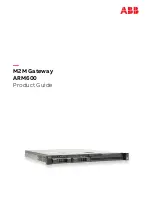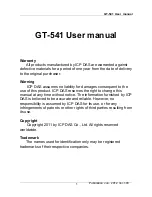
Version 5.8
331
October 2009
SIP User's Manual
6. Configuration Parameters Reference
Parameter
Description
Web: Comfort Noise Generation
Negotiation
EMS: Comfort Noise Generation
[ComfortNoiseNegotiation]
Enables negotiation and usage of Comfort Noise (CN).
[0]
Disable = Disable (default).
[1]
Enable = Enable.
The use of CN is indicated by including a payload type for
CN on the media description line of the SDP. The device can
use CN with a codec whose RTP time stamp clock rate is
8,000 Hz (G.711/G.726). The static payload type 13 is used.
The use of CN is negotiated between sides. Therefore, if the
remote side doesn't support CN, it is not used.
Note:
Silence Suppression must be enabled to generate CN.
Web/EMS: Default Release Cause
[DefaultReleaseCause]
Defines the default Release Cause (sent to IP) for IP-to-Tel
calls when the device initiates a call release and an explicit
matching cause for this release is not found.
The default release cause is
NO_ROUTE_TO_DESTINATION (3).
Other common values include NO_CIRCUIT_AVAILABLE
(34), DESTINATION_OUT_OF_ORDER (27), etc.
Notes:
The default release cause is described in the Q.931
notation and is translated to corresponding SIP 40x or
50x values (e.g., 3 to SIP 404, and 34 to SIP 503).
For an explanation on mapping PSTN release causes to
SIP responses, refer to Mapping PSTN Release Cause to
SIP Response on page
Web: Enable Microsoft Extension
[EnableMicrosofExt]
Modifies the called number for numbers received with
Microsoft's proprietary "ext=xxx" parameter in the SIP
INVITE URI user part. Microsoft Office Communications
Server sometimes uses this proprietary parameter to
indicate the extension number of the called party.
[0]
= Disabled (default).
[1]
= Enabled.
For example, if a calling party makes a call to telephone
number 622125519100 Ext. 104, the device receives the SIP
INVITE (from Microsoft's application) with the URI user part
as INVITE sip:622125519100;[email protected] (or
INVITE tel:622125519100;ext=104). If the parameter
EnableMicrosofExt is enabled, the device modifies the called
number by adding an "e" as the prefix, removing the "ext="
parameter, and adding the extension number as the suffix
(e.g.,
e
622125519100
104
). Once modified, the device can
then manipulate the number further, using the Number
Manipulation tables (refer to ''Number Manipulation and
Routing Parameters'' on page
) to leave only the last 3
digits (for example) for sending to a PBX.
EMS: Use SIP URI For Diversion
Header
[UseSIPURIForDiversionHeader]
Sets the URI format in the SIP Diversion header.
[0]
= 'tel:' (default)
[1]
= 'sip:'
Содержание mediapack MP-500
Страница 1: ...Document LTRT 12801 October 2009 User s Manual Version 5 8...
Страница 2: ......
Страница 22: ...SIP User s Manual 22 Document LTRT 12801 MP 500 MSBG Reader s Notes...
Страница 24: ...SIP User s Manual 24 Document LTRT 12801 MP 500 MSBG Reader s Notes...
Страница 290: ...SIP User s Manual 290 Document LTRT 12801 MP 500 MSBG Reader s Notes...
Страница 440: ...SIP User s Manual 440 Document LTRT 12801 MP 500 MSBG Reader s Notes...
Страница 564: ...SIP User s Manual 564 Document LTRT 12801 MP 500 MSBG Reader s Notes...
Страница 566: ...SIP User s Manual 566 Document LTRT 12801 MP 500 MSBG Reader s Notes...
Страница 573: ...Version 5 8 573 October 2009 SIP User s Manual 13 Technical Specifications Reader s Notes...
Страница 574: ...User s Manual Version 5 8 www audiocodes com...
















































